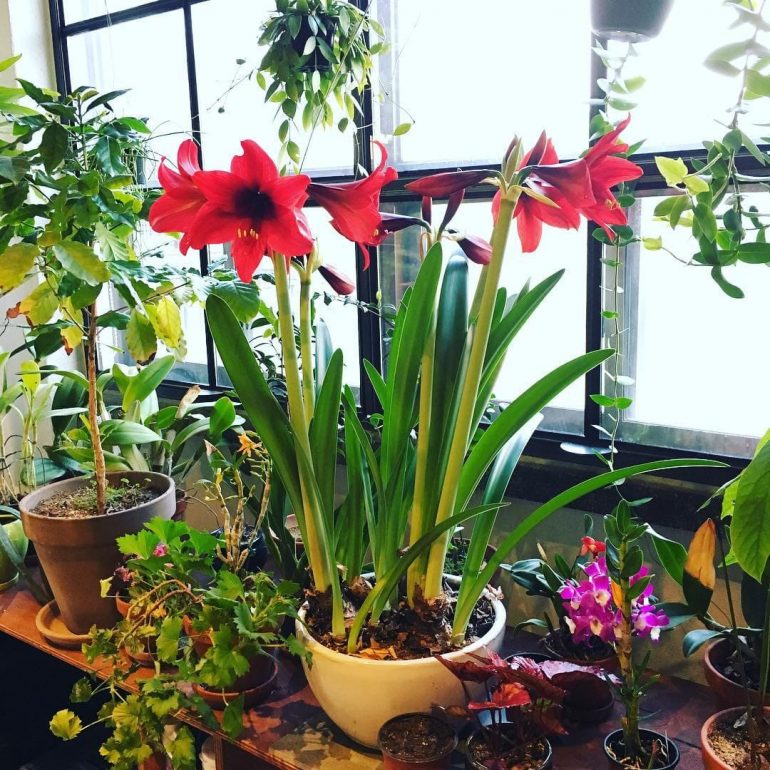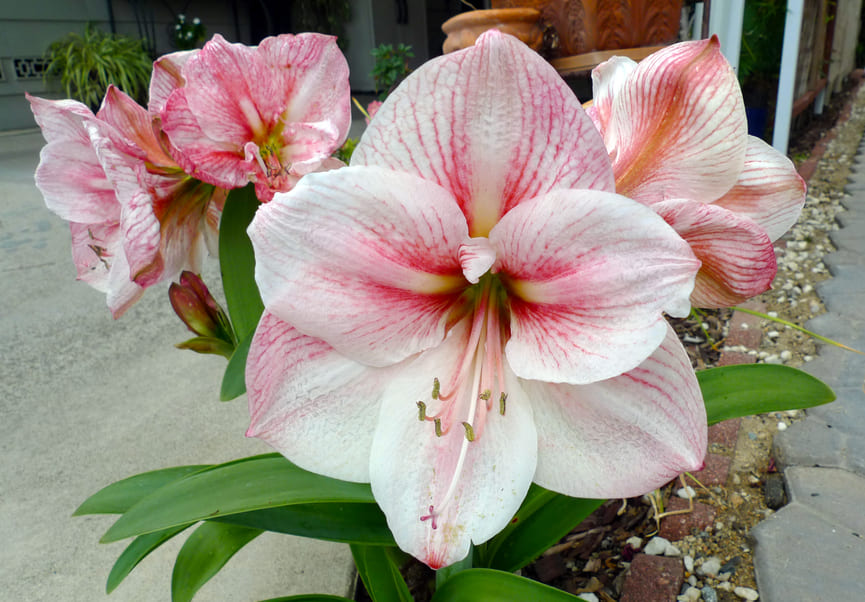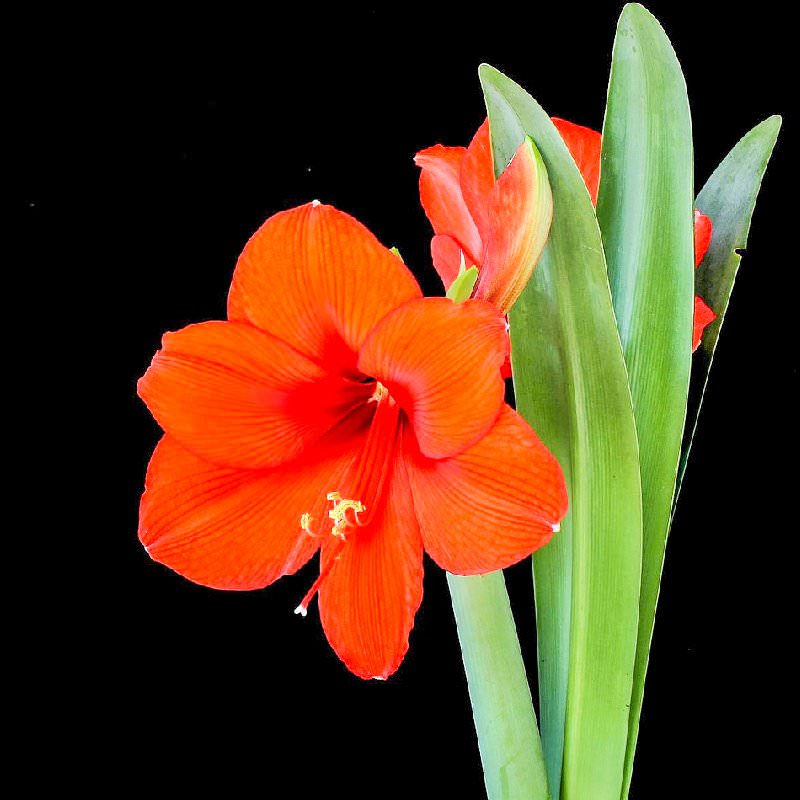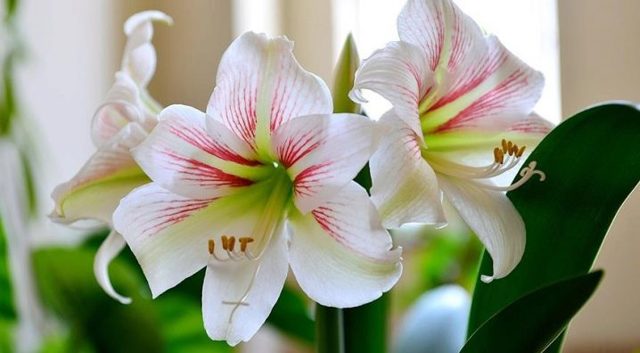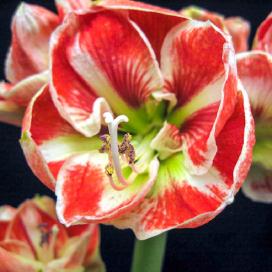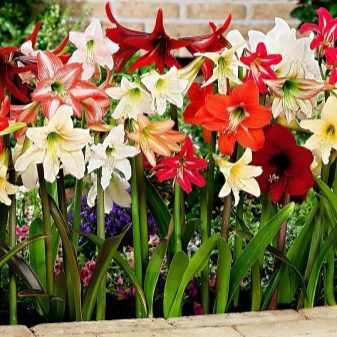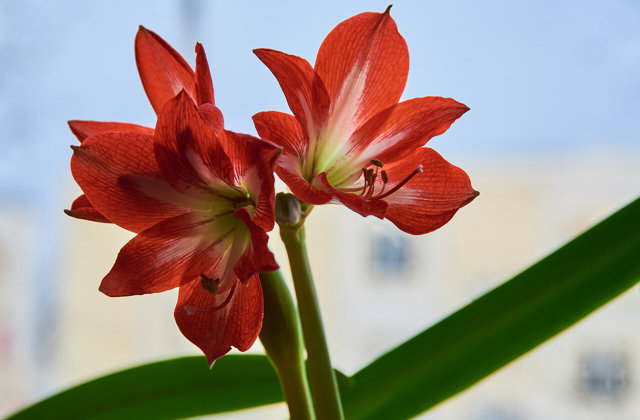Maintenance and care of hyperastrum: how to plant a flower correctly
The flower is propagated mainly by bulbs and children. With seed reproduction, varietal traits are not completely transmitted to the offspring. Seedlings bloom in the 3-4th year. To obtain seeds, flowers are artificially pollinated. When grown in earthen mixtures in summer, they are kept on a sunny window or on a balcony, watered abundantly and fed. In August, after the end of growth, watering is gradually reduced, at the end of September, dead leaves are cut off, watering is stopped completely, and only occasionally (about once a month) water is poured into a pan to prevent the roots from dying off, however, the earth in pots with resting bulbs should be to the touch dry, not damp. The pots with resting bulbs are kept in a dry and dark place at a temperature of about + 7-10 ° C. A lower temperature is harmful to indoor hippeastrum even during a dormant period.
In December-February, pots with bulbs are placed in a warm place with a temperature of + 20-25 ° C (for example, near a stove or central heating battery) and do not watered at all until the flower arrow appears, after which the pots are transferred to a light window and poured into a tray warm water so that the dried earth is well saturated with it. If the water has cooled down, and the top layer of soil in the pot is still dry, the cooled water is replaced with warm water several times. Until the flower arrow reaches 7-9 cm in height, water it very sparingly, otherwise the leaves will grow and the flowers will not develop. Then watering is gradually increased.
In 30–40 days after flowering, hippeastrum is transplanted into a nutrient mixture composed of leafy, humus and turf soil with an admixture of washed coarse sand (1: 2: 1: 1). With proper cultivation and care, hippeastrum is transplanted every 2-3 years. Annual replanting is not required, but the top layer of the earth must be changed every year. When transplanting, the bulbs are removed from the pot, shaken off all the old soil from the roots and the decayed roots are cut off with a sharp knife. The bulb should sit no deeper than 2/3 of its height in the ground. The transplanted indoor hippeastrum is kept on a light window in a warm room and watered with warm water. The pots shouldn't be too spacious. It is enough if the distance between the wall and the bulb is 2–3 cm. In a very spacious container, the plant may not bloom for a long time.
A faster way of vegetative propagation of the hippeastrum flower at home is by dividing the bulbs. Up to 40 babies can be obtained from one mature bulb. The onion is cut so that each part has a piece of the bottom and scales, the slices are sprinkled with crushed charcoal and the onion slices are planted in boxes with a light peat mixture. After 40-50 days, babies are formed, which are planted in pots next spring.
Many growers advise planting and caring for hippeastrum in a hydroponic culture. It is grown in double flowerpots on a nutrient substrate made of expanded clay with sand in a ratio of 2: 1 on LTA-2 solution. Hydroponic cultivation is a snap. In the autumn-winter period, when the leaves are dead, the plant is kept somewhere in a semi-dark place at + 7–8 ° C in a solution of very low concentration (25–45%), periodically moistening expanded clay around the inner pot, where part of the roots is also preserved. Since January, flowerpots with bulbs are exposed to light and, with the appearance of a flower arrow, the concentration of the nutrient solution is increased to 100%. At this time, it needs good lighting and a temperature of + 20-22 ° C. After the development of the flower arrow, the leaves grow.Strong specimens of hippeastrum at home give two inflorescences with three huge flowers. Intense, green, erect leaves catch up with the flower arrow in growth. By autumn, the plant gradually moves to a dormant period, the leaves die off. After flowering, the babies are separated from the mother bulb. The maintenance and care of hippeastrum is possible not only as a pot culture, but also in the winter garden.
Reproduction of hippeastrum
Reproduction of hippeastrum by children
Hippeastrum propagates by seeds, by dividing the bulb and by children. It is easier to implement a vegetative method that preserves all the characteristics of the parent hippeastrum in the new plant. When transplanting, well-formed children of the hippeastrum with developed roots that have reached a diameter of 2 cm are separated from the mother bulb and, having treated the fracture sites with crushed coal, are seated in separate pots to a depth of 2 cm.Do not cut leaves from young plants for two years, even during dormancy ... The daughter bulbs of the hippeastrum bloom in the third or fourth year.
Reproduction of the hippeastrum by dividing the bulb
Some varieties of hippeastrum do not form children, so they are propagated by dividing the bulb. With a sharp sterile knife, the onion is cut into several parts so that each has a part of the bottom with roots. The sections are treated with wood ash or crushed charcoal, dried for several days, after which the cuttings are laid out in separate pots with perlite or with a mixture of sand and peat so that parts of the bottom with roots simply lie on the substrate.
You can not cut a large onion into pieces to the end, but simply make several deep cuts on it at the same distance from each other, without cutting the bottom. The wounds are treated with charcoal, the onion is dried for two to three days and placed in a pot on a substrate consisting of perlite or a mixture of peat and sand. Water the onion through a pan, and after a while, children form at its base. You already know how to separate and arrange them.
Hippeastrum from seeds
Hippeastrum is also propagated by seed, however, the disadvantage of generative reproduction is that it does not preserve the varietal properties of the parent plant in the offspring, therefore, it makes sense to grow only species of hippeastrum from seeds.
It is necessary to sow the seeds of hippeastrum immediately after they ripen, when they have almost one hundred percent germination. They are buried in the ground to a depth of 1 cm, watered, covered with foil and the crops are placed in a warm place. Seedlings will appear in 2-3 weeks, and as soon as this has happened, you will need to immediately remove the cover and place the seedlings in the brightest place under a bright but diffused light. The grown seedlings are seated in separate cups and, as they grow and develop, are fed with a weak solution of mineral fertilizer for deciduous plants. Young plants do not need a dormant period.
Benefits and harm to humans
It is worth remembering that the juice of the bulbs is poisonous, so all manipulations are carried out with gloves. It is not allowed to get juice on mucous membranes and skin. When working without gloves, at the end of the work, you should immediately wash your hands with soap and water.
Amazing properties are attributed to Hippeastrum. It is believed that this flower disposes to fantasies, therefore, it is simply necessary for writers. Also, the plant is beneficial in kindergartens, supporting the creative thinking of children. Naturally, at the same time, they put it in places that are not accessible to children. It is not recommended to place hippeastrum at work, unless it is associated with creativity.
Diseases and pests of garden and indoor flowers
Even if the plant is not planted in open ground for the summer, it can get sick or acquire pests in indoor conditions. Most often, hippeastrums are subject to diseases such as red burn fungus, downy mildew and red rot. You can determine the disease by the appearance of the flower:
- leaves and bulb covered with red spots - fungal burn;
- a white bloom appeared on the leaves - powdery mildew;
- lethargic leaves and the formation of putrefactive secretions on the bulb are rot.

Red burn of the hippeastrum
They get rid of rot as follows:
- carefully examine the flower and the underground part, remove the affected areas;
- the onion is left alone for several hours, allowing it to dry;
- prepare new soil:
- before planting, the bulb is treated with Fundazole solution.
To get rid of powdery mildew will help special preparations that can be purchased in flower shops. To get rid of a red burn, the bulb should be dug up and all affected areas should be trimmed. Places of cuts are treated with a mixture of copper sulfate and chalk (1:20). The bulb is left in this form for a week, after which it is planted in new soil. It is advisable to treat the soil with a suitable fungicide before planting.
The most common pests of indoor hippeastrum are scale insects, spider mites, aphids and worms. You can get rid of them with the help of special insecticides.
Diseases and insects can be the main reason why hippeastrum does not bloom. It is necessary to timely detect pests and diseases that can harm this beautiful plant.
It will also be interesting: Vallotta - home care and types of indoor plants?
Home care for hippeastrum
How to care for hippeastrum
The indoor flower hippeastrum needs good lighting, so it is preferable to keep it on the southern, southwestern and southeastern windowsills, provided that direct sunlight will not fall on the plant at midday. In order for the flower to remain compact and slender, it needs to be rotated around the axis from time to time. In the warm season, hippeastrum is comfortable at 17-25 ºC, but it will be even better if you place it in the garden, on the terrace or balcony, while protecting it from drafts and too bright sun.
Growing hippeastrum involves the regular application of fertilizers to the substrate. Home hippeastrum is fed twice a month from the beginning of the period of active growth with a solution of mineral fertilizers for deciduous plants, and when the flower has leaves, they switch to fertilizers for flowering indoor plants, watering the soil in a pot with them in the same mode. The concentration of the solution should not be too strong, otherwise you may burn the roots of the plant. When the flower arrow of the hippeastrum reaches 12-15 cm, pour it with a pale pink solution of potassium permanganate, and after a few days add phosphorus fertilizer to the soil.
Watering hippeastrum
At the beginning of the growing season, after the hippeastrum leaves the dormant period, watering is carried out very moderate, even meager, but gradually the water consumption and the frequency of watering increase: the hippeastrum in a pot should not feel thirsty, especially during the period of peduncle formation and the appearance of buds. As soon as the flower arrow reaches a height of 7-8 cm, the substrate must be kept in a slightly damp state all the time: the blooming hippeastrum is in need of moisture. To prevent water from getting on the bulb, it is better to moisten the soil by bottom irrigation: the settled water at room temperature is poured into the pan under the pot until the entire earthen lump of hippeastrum is wet. When the dormant period begins, watering is gradually reduced until it stops completely.
Hippeastrum transplant
There is no need to torment the indoor hippeastrum with annual transplants. It is enough to transfer it from a cramped pot into a new one, 2-3 cm larger in diameter, once every 3-4 years. The hippeastrum is planted in a new pot after flowering or after a dormant period. The container for the plant is chosen narrow and high: between the bulb and the walls of the pot there should be a layer of earth no more than 2 cm thick.Hippeastrum soil needs approximately the following composition: one part of humus, sand and peat and two parts of sod land. Or: one part of humus, and two parts each of leafy earth, perlite (coarse sand) and sod land. Be sure to place a thick layer of drainage material on the bottom of the pot. After transshipment of the hippeastrum and filling the space in the pot with soil mixture, the bulb of the plant should look out of the substrate for at least a third of its body. If you do not intend to replant the plant in any season, change the top layer of the substrate 5 cm thick in the pot.
Hippeastrum after flowering
For a plant to bloom every year, it must be fully resting. The dormant period of the hippeastrum usually lasts from late summer to late October. After complete drying of the leaves, during which watering is gradually reduced, and plant feeding is stopped altogether, you need to remove the wilted leaves, cut off the stem, transfer the hippeastrum to a dark dry room with a temperature not higher than 10-12 ºC, put the pot with the bulb on its side and leave without watering for 6-8 weeks. After this period, the flower is returned to its usual place, they begin to water a little and resume feeding.
Some hobbyists grow hippeastrum without letting it rest. They keep it in a warm room all year round, water it and fertilize it. However, neither a person nor a plant can go without rest and sleep for a long time, so be prepared for the fact that one day, despite all your worries, the hippeastrum will stop blooming.
Home care for hippeastrum
Proper care of a home hippeastrum includes the creation of certain conditions: temperature, light level, room humidity. These indicators may vary depending on the phase of flower development. The decorative beauty of each plant will depend on proper care.
Lighting
A light-loving plant will feel comfortable on the southeast, south or southwest side of the house. In the wild, the flower grows in the steppes, so it is not afraid of direct sunlight. It can be placed both in direct light and in a room with diffused light. On very hot days, it is advisable to shade the flower from the excessively scorching sun. Bulbs of hybrids that shed their leaves during a dormant period can be taken to a cool and dark place.
Temperature regime
Low temperatures (below 5 ° C) have a bad effect on the formation of the peduncle. During the dormant period, the bulb is able to survive with a short-term temperature drop to -1 ° C.
Sharp temperature changes have a bad effect on the development of the flower.
The optimal temperature indicator for a plant:
- during daylight hours - 20-22 ˚С;
- in the dark - at least 18 ˚С.
The maximum allowable humidity in the environment is 80%. High humidity can cause disease and even death of the plant. You should not spray the leaves, it is better to sometimes wipe them from dust with a damp cloth.
How to properly water and feed
Proper watering for a flower is very important, because at different periods it needs a certain amount of moisture. At the first signs of hibernation, watering is completely excluded. You can add a little water to the pan for vital processes in the bulb. After waking up, they begin to water in moderation and quite rarely - once every two weeks.
During the formation of the peduncle, the flower is watered regularly, while adhering to the following recommendations:
- water for irrigation should be at room temperature;
- the soil should not be excessively moist;
- between waterings, the soil should dry out;
- it is impossible for the liquid to get on the bulb.
In the wild, hippeastrum blooms only during the rainy season, and in drought, the bulbs rest. Therefore, the frequency of watering should mimic natural conditions.
The plant needs high-quality and timely feeding. Fertilize once every ten days. During the dormant period, the flower is not fed.The composition of fertilizers depends on the stage of flower development:
- The beginning of growth requires nitrogen-potash fertilizers.
- For the full formation of the peduncle, top dressing is applied, which contains potassium, nitrogen and phosphorus.
- In the flowering phase, they are fed with phosphorus-potassium complexes.
The first feeding is applied after the flower arrow reaches a height of 10-15 cm.
Soil and pot
To make it easier for the flower to assimilate nutrients, the filler in the pot should be light and loose, have excellent moisture and water permeability. Experienced growers advise preparing the substrate from the following components: peat, deciduous soil and river sand. You can purchase ready-made filler at a flower shop. Begonia soil will be an excellent soil for a flower.
Sometimes ash or compost is added to the ground.
To grow this variety, you should purchase a narrow and tall flowerpot. This is due to the rather long roots of the plant, which feed the bulb even in the resting phase. Choose a flowerpot that is not too spacious: the distance between the pot and the bulbs should not exceed 2 cm.
Preparation for winter and dormant period
The dormant period lasts from September to January. If the flower was planted in the open ground for the summer season, then with the arrival of autumn it should be transferred to the apartment. Watering the flower is gradually reduced, the leaves begin to dry out. After the leaves and stems are completely dry, the stem is removed and the bulb is placed in a dark place.
The pot is moved on its side and left at a temperature of 10-12 ° C for 6-8 weeks.
The flower is able to do without the resting stage. To do this, throughout the year, he must be under bright light, in a warm room and regularly receive fertilizers and watering. With this mode, the flower can bloom in mid-autumn or mid-spring. The rich green foliage does not lose its appeal all year round.
It will also be interesting: Amaryllis - caring for a flower at home, planting and growing?
Signs and superstitions
Hippeastrum can be found in many parts of the world. That is why a large number of signs and superstitions are associated with it. Here is some of them:
- Hypeastrum is able to get rid of bad mood, relieve depression and fatigue, establish friendly and loving relationships, reduce irritability.
- This flower helps to realize creativity and is appropriate in the home of writers and artists.
- Hippeastrum is a flower of desires. Say the cherished words over the plant pot and wait for the result.
- Of the negative qualities of the plant, it should be noted its ability to absorb negative energy. Therefore, in no case should you quarrel near the bush.
- When an unwanted guest appears in the house, you can find out his intentions. Just ask him to touch the petals and follow the reaction of the plant after leaving. If the flower begins to wither, then the guest came with malicious intent.
- If a girl is not sure of the love of her chosen one, there is such a sign: you need to ask your partner to give a hippeastrum flower and grow a plant. When leaves or a flower arrow appear, one can say about the sincerity of feelings.
- Hippeastrum gives confidence and determination to individuals with weak energy, helps to find harmony and peace of mind.
- During flowering, place the pot in the center of the room and your home will be filled with positive energy.
- This flower is recommended for single men looking for romantic dates. To do this, you need to plant the hippeastrum yourself in a pot and success with the opposite sex is guaranteed.
In order for the hippeastrum to feel good, it is necessary to provide it with proper care at home. This is not difficult to do, following the recommendations described in the article.
Growing problems
With the lack of watering, the leaves turn pale, the flowers tilt their heads. It is recommended to keep the soil slightly moist during flowering.
At low temperatures, the flowers begin to turn black. It is required to transfer the plant to a warm place.
If the leaves are dull and wither, then this indicates excess moisture in the pot. It is recommended to reduce watering by letting the soil dry beforehand.
If the flowers become dim, then you need to shade them from the rays of the sun.
The leaves of the hippeastrum turn yellow, and also dry up in anticipation of a dormant period.
If this happens at a different time, then pay attention to non-compliance with the recommendations in the care (damp or cold). Examine the plant for any parasites that can cause yellowing of the leaves.
With proper care and adherence to the irrigation and feeding system, hippeastrum (photo above) will delight you with its beautiful flowering from year to year.
Reproduction of hippeastrum
Subject to the rules of care and storage of the bulb, the flower can be grown for more than 10 years. In addition, several methods of reproduction of the hippeastrum are available at home. A perennial is grown from seeds, propagated by dividing the bulb or its children. The last two methods are simpler and faster.
Seed propagation
It is better to sow seeds immediately after harvest, as they lose germination
To obtain hippeastrum seeds, flowers must be pollinated. This experiment is best done outdoors. After the plant has faded, the seeds ripen in the box within two months. This process will speed up spraying the flower with a 5% boric acid solution. Since the seeds quickly lose their germination, it is recommended to sow them immediately after collection. For this:
- wrap the seeds in a wet rag, put them in a container, cover them with glass and leave them in a warm place for 10 days - this soaking will help speed up germination;
- naklyuvannye seeds are embedded in a mixture of deciduous soil, sand and peat to a depth of about 2 cm;
- seedlings appear in 2-3 weeks. They need a lot of light, at the same time, the seedlings must be shaded from direct sunlight;
- when two true leaves are formed, the plants dive into separate 7-centimeter pots;
- seedlings are watered moderately, fertilizing with mineral fertilizers is carried out until mid-August.
The first two years, young plants do not need dormant periods. At the age of three to four years, when the bulb has reached a size of 5 cm in diameter, you can start forcing the plant. To do this, in August, watering is reduced, and in September, they stop altogether. In late winter - early spring, you can expect the first flowering of hippeastrum.
Reproduction by children
When propagated by children, flowering can be obtained after 3 years.
In order to fully preserve varietal characteristics, the most decorative hybrids are propagated by separating daughter bulbs. The size of the bulbs is at least 2 cm, they must be well formed and have their own roots. The babies are separated during the transplant.
The education of children can be stimulated. For this purpose, the bulb is deeply cut into 2-4 lobes. The sections are treated with charcoal and allowed to air dry for several days. After that, the onion is placed in a sand-peat mixture, the substrate is moistened only through the pallet. After a while, daughter bulbs form at the base.
The reproduction process is carried out in the following sequence:
- children are planted in a container with a nutrient mixture to a depth of 3-4 cm;
- in the first two years of planting, they are kept in a well-lit place;
- watering is moderate, in winter its frequency is reduced.
In the third year, the plants are transplanted into separate pots. Caring for them is the same as for an adult hippeastrum. Reproduction by children ensures flowering in three to four years.
Reproduction by dividing the bulb
There are times when plants cannot form children. The solution will be reproduction by dividing the bulb. For this:
- the onion is cut into 4-8 parts, each of which must have a bottom and roots;
- the sections are treated with crushed charcoal and dried for 2-3 days;
- planting material is placed in a nutrient mixture of sod land, sand and peat.
The soil is kept moist, the air temperature is at the level of + 23 ... + 25 ° С. When young plants begin to sprout from the bulbs, they are planted in separate pots and routinely maintained.
Pests and diseases of the hippeastrum
Diseases of the hipperastrum
A dangerous disease that can affect the hippeastrum is staganosporosis, or a red burn of the bulbs. As soon as you find red streaks or dots on the bulb, you need to immediately cut them all out to healthy tissue. Examine the roots of the hippeastrum and remove those that are dead, cut off any leaves with signs of damage. All sections must be treated with Fundazol, Maxim or Fitosporin-M. Dry the bulb within a week and after making sure that there are no new lesions, plant it in a new pot with fresh substrate so that only the roots are in the ground: this will make it easier for you to monitor the condition of the bulb in the future. The first 2-3 weeks after transplanting, watering the hippeastrum is carried out through the pallet with solutions of the listed fungicides. When you’re sure the plant is safe, you can add some soil to the pot to cover the bottom of the bulb.
Hippeastrum at home can also be affected by fungal diseases anthracnose and fusarium. The plant is treated for these diseases in the same way and with the same fungicides as the red burn: the damaged areas are removed, the sections are treated with Maxim, Fundazol or Fitosporin-M, the hippeastrum is transplanted into a new pot with a fresh substrate and watering is carried out into the pan with fungicide solutions.
Hippeastrum pests
Hippeastrum can be affected by pests such as mealybugs, scale insects, onion and spider mites. Those pests that can be seen with the naked eye should be removed from the plant with a cotton pad dipped in alcohol or soapy water. Insects are removed from hard-to-reach places with an ear stick. After this procedure, the flower must be treated with an insecticide solution. In the case of mites, which are not insects, but arachnids, acaricides or insectoacaricides are used to treat the plant on the leaves - Actellik, Karbofos or Fitoverm. Most likely, one treatment will not cope with the problem, and you will have to spray hippeastrum 3-4 times.
Why hippeastrum does not bloom
Sometimes hippeastrum refuses to bloom at the right time, and readers ask how this can be explained. There may be several reasons:
- deficiency of nutrients in the soil;
- lack of strength due to illness, pest damage or insufficient rest;
- rotting of the bulb due to waterlogging of the soil.
In order to make hippeastrum bloom, there are several tricks:
- before planting, the bulb is kept in water for three hours at a temperature of 43-45 ºC;
- provide the plant with a full dormant period;
- in July, you need to cut off all the leaves from the hippeastrum, deprive it of watering for a month, and then moisten it through the pallet, and then add a solution of complex fertilizer to the soil. In a month and a half, the hippeastrum will bloom.




